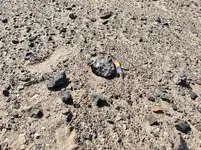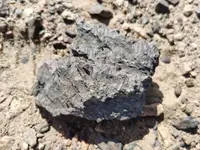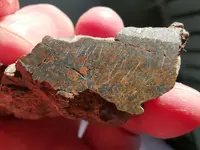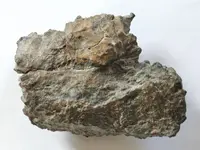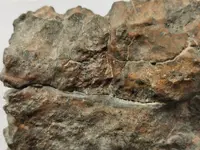You are using an out of date browser. It may not display this or other websites correctly.
You should upgrade or use an alternative browser.
You should upgrade or use an alternative browser.
Is it a meteorite?
- Thread starter okstone
- Start date
No, it is not a meteorite. While attracted to a magnet, that, alone, does not tell us much, since many terrestrial rocks are also attracted to magnets.
Neither the cut face, nor any part of the rock shown has any visible characteristics of meteorites.
Time for more coffee.
Neither the cut face, nor any part of the rock shown has any visible characteristics of meteorites.
Time for more coffee.
Kray Gelder
Gold Member
- Joined
- Feb 24, 2017
- Messages
- 7,005
- Reaction score
- 12,558
- Golden Thread
- 0
- Location
- Georgetown, SC
- Detector(s) used
- Fisher F75
- Primary Interest:
- Metal Detecting
I don't think so. I looked at the other rocks lying about in your first pic. Smaller pieces appear exactly the same as your example. They all appear to have windblown sand abrasion/polishing.
Kray Gelder
Gold Member
- Joined
- Feb 24, 2017
- Messages
- 7,005
- Reaction score
- 12,558
- Golden Thread
- 0
- Location
- Georgetown, SC
- Detector(s) used
- Fisher F75
- Primary Interest:
- Metal Detecting
Seems like a lot of fractures to withstand the stress of passing through the atmosphere. IMO.
Back-of-the-boat
Gold Member
- Joined
- Apr 18, 2013
- Messages
- 7,019
- Reaction score
- 8,855
- Golden Thread
- 0
- Location
- California
- Detector(s) used
- AT GOLD/Garrett /C.Scope cs4PI/Garrett(carrot) pro pointer/ 5x8 double d coil and sniper coil/Lesche digger/Lesche "T" handle shovel.
- Primary Interest:
- All Treasure Hunting
Maybe fragments of the 1908 meteor that hit Tunguska in Russia, it is theorized it exploded 3 to 6 miles up in the atmosphere and if this is in the path that meteor was on, it could be a piece, see if you can find if where you found it was in the trajectory that the Tunguska meteor was on, If you can find trajectory mapping.
Raider19962
Sr. Member
- Joined
- Mar 4, 2018
- Messages
- 298
- Reaction score
- 566
- Golden Thread
- 0
- Location
- Delaware, The First State
- Detector(s) used
- White's, Technetics, Fisher M, AT Pro
- Primary Interest:
- All Treasure Hunting
It's a meteor-wrong! I found a few of those in Arizona.
- Joined
- Dec 23, 2019
- Messages
- 6,329
- Reaction score
- 20,209
- Golden Thread
- 0
- Location
- Surrey, UK
- Primary Interest:
- All Treasure Hunting
It's not a meteorite. Fractures like that are not at all uncommon on stony meteorites (see below) but they're shock features created on impact. Note the smooth ablation surfaces on the specimen below. Meteorites of this type don't typically have the angular irregular appearance seen on what you found.

There's no reason to single out the Tunguska event either. Plenty of other meteorites to choose from... but this isn't one of them. In any case the Tunguska impactor appears to have suffered almost complete destruction by detonation in the upper atmosphere and no reliably identified remnants have been found to date, apart from microscopic spherules. It also came in from a SE direction, on a path that was nowhere near Xinjiang.
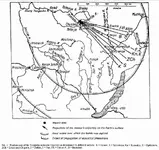
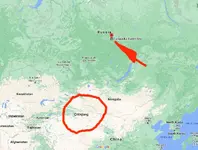

There's no reason to single out the Tunguska event either. Plenty of other meteorites to choose from... but this isn't one of them. In any case the Tunguska impactor appears to have suffered almost complete destruction by detonation in the upper atmosphere and no reliably identified remnants have been found to date, apart from microscopic spherules. It also came in from a SE direction, on a path that was nowhere near Xinjiang.


okstone
Jr. Member
- #9
Thread Owner
It's not a meteorite. Fractures like that are not at all uncommon on stony meteorites (see below) but they're shock features created on impact. Note the smooth ablation surfaces on the specimen below. Meteorites of this type don't typically have the angular irregular appearance seen on what you found.
View attachment 1868310
There's no reason to single out the Tunguska event either. Plenty of other meteorites to choose from... but this isn't one of them. In any case the Tunguska impactor appears to have suffered almost complete destruction by detonation in the upper atmosphere and no reliably identified remnants have been found to date, apart from microscopic spherules. It also came in from a SE direction, on a path that was nowhere near Xinjiang.
View attachment 1868311 View attachment 1868312
Thank you. I'm confused by its magnetism. Maybe it's a meteor-wrong.
- Joined
- Dec 23, 2019
- Messages
- 6,329
- Reaction score
- 20,209
- Golden Thread
- 0
- Location
- Surrey, UK
- Primary Interest:
- All Treasure Hunting
Thank you. I'm confused by its magnetism. Maybe it's a meteor-wrong.
Many terrestrial rocks are magnetic. As a test, it tells you very little on its own.
Back-of-the-boat
Gold Member
- Joined
- Apr 18, 2013
- Messages
- 7,019
- Reaction score
- 8,855
- Golden Thread
- 0
- Location
- California
- Detector(s) used
- AT GOLD/Garrett /C.Scope cs4PI/Garrett(carrot) pro pointer/ 5x8 double d coil and sniper coil/Lesche digger/Lesche "T" handle shovel.
- Primary Interest:
- All Treasure Hunting
It's not a meteorite. Fractures like that are not at all uncommon on stony meteorites (see below) but they're shock features created on impact. Note the smooth ablation surfaces on the specimen below. Meteorites of this type don't typically have the angular irregular appearance seen on what you found.
View attachment 1868310
There's no reason to single out the Tunguska event either. Plenty of other meteorites to choose from... but this isn't one of them. In any case the Tunguska impactor appears to have suffered almost complete destruction by detonation in the upper atmosphere and no reliably identified remnants have been found to date, apart from microscopic spherules. It also came in from a SE direction, on a path that was nowhere near Xinjiang.
View attachment 1868311 View attachment 1868312
I couldn't find a trajectory map that is why I told O.P. to find trajectory mapping.
- Joined
- May 28, 2010
- Messages
- 20,258
- Reaction score
- 32,187
- Golden Thread
- 1
- Location
- White Plains, New York
- 🥇 Banner finds
- 1
- 🏆 Honorable Mentions:
- 1
- Detector(s) used
- Nokta Makro Legend// Pulsedive// Minelab GPZ 7000// Vanquish 540// Minelab Pro Find 35// Dune Kraken Sandscoop// Grave Digger Tools Tombstone shovel & Sidekick digger// Bunk's Hermit Pick
- Primary Interest:
- Metal Detecting
Ironstone. 

Similar threads
Users who are viewing this thread
Total: 1 (members: 0, guests: 1)

